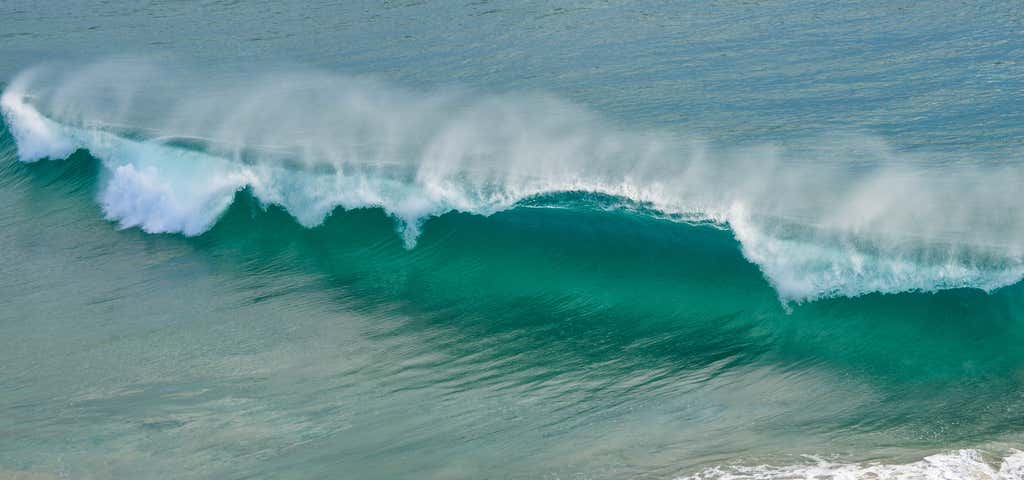The southwest-facing coastline of South Australia runs 3,816km from Mount Gambier in the east and right across the Nullarbor to claim the lion’s share of the Great Australian Bight. Add in the state’s many islands and we’re talking more than 5,000km of wave-rich, mostly deserted line-ups. One of the last frontiers of Australian surfing, South Australia’s coastline is a treasure chest of surf discovery with three peninsulas and Australia’s third largest island the true jewels in the crown. You’ll need a good wetsuit here and a healthy dose of respect for the locals and local wildlife.
Y-Steps
We’ll give this to you straight – if you want to surf in South Australia’s capital city of Adelaide then know two things. Firstly, it’s never going to be pumping thanks to being sandwiched between the Yorke Peninsula to the west and Kangaroo Island to the south. Secondly, if it is going to be surfable then you’ll need to be there on the pushing tide from mid-to-high. If some swell finds its way into the St Vincent Gulf then Y Steps is your best bet with scattered peaks offering the most promise. If the swell is pushing then try the reef at Christies Beach, which is also one of the few low-tide spots in the city. But if you have any sense of adventure you’ll want to be heading west or south to discover South Australian surfing at its finest. Read on …
Waitpinga Beach
Located in Newland Head Conservation Park, just west of Victor Harbour, Waitpinga Beach is one of the jewels in the Fleurieu Peninsula crown. Wave quality is dependent on sand aligning the banks, but submerged rock outcrops help to focus any swell that makes its way around Kangaroo Island. Waits, as it is known, is a bit of a magnet and usually holds some size when everywhere else is small. In clean swell and a stiff offshore you’ll encounter A-frame peaks that barrel beautifully. It has a reputation as one of South Australia’s sharkiest surf spots, so maybe avoid the dawnie, solo surf or that alluring evening glass off.
Vivonne Bay
Vivonne Bay sits in a sheltered nook on the southern edge of Kangaroo Island. The bay faces southeast and has waves to suit almost everyone. Offshore in the norwester and westerly, this crescent of sand is lined with peaks and banks that come to life with a decent southwest swell. Like all breaks on Kangaroo Island you’ll feel insignificant and vulnerable out in this line-up, but its sheer beauty and clear water will win you over. Oh and do make sure you’ve the time to dine on a locally caught crayfish after your surf …
Cape Kersaint
On the very southern edge of Kangaroo Island, directly southwest of Adelaide, you’ll find Cape Kersaint and one of South Australia’s most remote lefthanders. Cape Kersaint lies in the Vivonne Bay Conservation Park just west of Vivonne Bay, but it is nothing like its more gentle neighbour. This point springs to life with the big southerly swells as the wave energy emerges from the depths to meet the rocky shelf. There are barrel sections and enough raw power to keep even the best surfers on their toes.
Pondalowie Bay
One of the most popular beaches inside Innes National Park is Pondalowie Bay. This beach and reef combination bay produces a short, stabby left that can get very hollow and a right-hander with longer walls that can handle some size. In summer this is a good option as the prevailing east/southeast winds are directly offshore. Plus, there is a campground just 400m from the main break. Too easy.
Chinamans Hat Island
Jutting right out into the southern Indian Ocean, on the very tip of Yorke Peninsula in Innes National Park, you’ll discover Chinamans. This reef holds an incredible left and a right, but it is the left that makes this break one of South Australia’s finest attractions for the more experienced surfer. Expect a serious heart-in-your-mouth take-off and prepare for some tube time as this wave peels across the shallow reef. The bigger it gets out here, the better the wave gets. If you’re not feeling it then try Baby Chinamans to the east – it’s less intense and handles the low tide fine.
Blackfellows
The Eyre Peninsula is more than 2,000km of incredible coastline with quality surf spots around every nook and cranny. Most of them are well-kept secrets heavily guarded by the Eyre Peninsula surfing population that has terrorised visiting pros, photographers and disrespectful travellers since the first waves were discovered. This is the wild west of surf culture, but show respect here and you’ll be fine. Blackfellows Point is a big left-hand reef break that can handle plenty of size and works on the big southwest swells straight out of the Southern Ocean. Located near Elliston, the wave is considered one of the most powerful in South Australia. If you do nab a barrel here you won’t ever forget it ... ever.
Salmon Hole
Located just south of Daly Head, Salmon Hole is a premium right-hand point break on the Yorke Peninsula’s west coast. This picturesque line-up offers fast and hollow rights with the odd section of reef and a well-placed suck rock. You’ll want the wind from the north for this spot to shine, but if you get a southerly shift then there are options on the north side of Daly Head. You’ll swiftly learn why Daly Head earned its place as South Australia’s first National Surfing Reserve.
Granites, Streaky Bay
If Blackfellows Point proves too intimidating then the equally remote, but slightly more user-friendly lefthander of Granites might be your cup of tea. This left needs a decent swell to break properly, but really shines in a 3m-plus swell. The take-off is demanding, but the wave has a rippable wall and can break for more than 400m – you’ll need some paddle fitness here. Granites breaks over a rocky boulder bottom and can have mood swings – sections can turn on and off at the whim of shifts in the wind and swell direction. Make sure to check out the Streaky Bay pub with incredible views Streaky Bay pub has often been described as “the best pub in Oz”.
Cactus Beach
Cactus is the peninsula’s most popular bay with two left-hand reefs, Castles and Cactus, and a thumping right-hander called Caves. The beach is bordered by sand dunes and, like most surf spots on the Eyre Peninsula, you’ll need a 4WD to get here. Cactus Beach is right on the edge of the Nullarbor Plain. Be nice to the locals and you’ll come away with some great waves, memories and a bunch of new friends.
All of the last three waves in this list have experienced fatal shark attacks. There is a very healthy great white shark population living along the South Australian coast and while attacks are extremely unlikely, use commonsense when entering the water. Avoid sessions at sunrise and dusk, watch for increased bird activity and be mindful of recent sightings or activity.
Explore More Trip Guides
New South Wales Top Surf Spots
- 4 Places
Queensland's Best Surf Breaks
- 10 Places
Tasmania's Top Surf Breaks
- 10 Places
Victoria's Surf Hot Spots
- 10 Places












